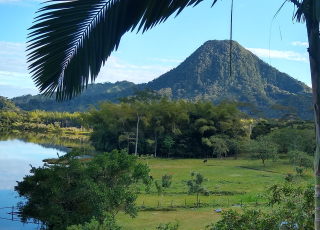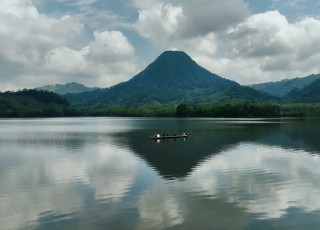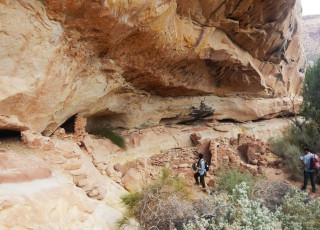Streams of Science: University Students Engaging in NHMU Research
By Cosette Reeves
There’s a special kind of camaraderie among the student body at a university. Bound by similar goals and shared anxieties, students have an unspoken agreement to fumble and succeed together. This collective drive has the power to push discovery forward—but when paired with the resources and mentorship of institutions like the Natural History Museum of Utah (NHMU), it can truly flourish.
Joining the Current

Zoe Kitson attempting to check results from PCR for the first time.
I recently met two University of Utah students—Isabella Calhoun and Zoe Kitson—who are among the 12 being mentored this semester by Postdoctoral Researcher Fellow Dr. Susana Velasquez-Franco. I found them in the Museum’s mycology lab, mid-battle with an extremely intricate process called Polymerase Chain Reaction (PCR). This method is used to amplify DNA segments to generate enough material for thorough study. Using multi-channel pipetting for the first time, Isabella and Zoe were attempting to use PCR to create copies of extracted ancient environmental DNA (sedaDNA) from a genuine set of Museum samples. The samples were collected last year from the Cerro Machín Volcano in Colombia by Susana and NHMU Curator of Botany Dr. Mitchell Power, and they contain a more-than-3,600-year-old, organic-rich record called gyttja. A gyttja record is a rare and valuable find! This was the moment I managed to walk into—a time when concentration was critical and stakes felt high.
Isabella and Zoe are just beginning to gain lab experience in genetics and were understandably nervous about working with original samples—a sentiment shared by many students. However, they expressed their excitement for being immersed in and contributing to veritable experimental research.
Students from a wide range of academic disciplines can engage with Museum research through two main avenues: the University’s College of Science program, Science Research Initiative (SRI), or their home department, committing a minimum of 5 – 10 hours a week to active research. Both Isabella and Zoe are engaged in Susana’s SRI Lake’s Memory research stream. Each stream is a focused scientific study for first- and second-year students, led by a university mentor and funded by SRI. Susana’s stream, jointly supported by SRI and NHMU, has transformed the Museum’s biology and paleoecology labs into research classrooms, giving students hands-on experience while advancing her work on the Cerro Machín record.
Channeling Curiosity
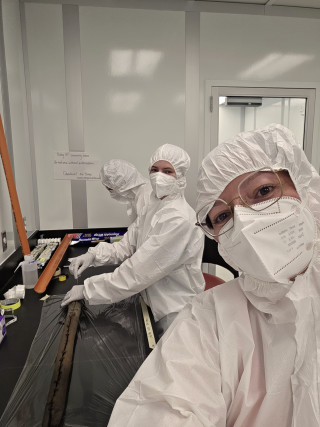
Zoe (a former student), Melanie, and Susana opening and subsampling the Cerro Machín wetland record in the Clean Ancient DNA Lab on campus.
The stream centers on one big question: how has the biodiversity in volcanic landscapes in the Andes recovered after being impacted by volcanic and climatic-driven disturbances? Students are helping to uncover the answer as they learn to gather and analyze data and apply those results to the real world—and they’re tackling big projects as they do so! They are reconstructing wildfire history using records from volcanic wetlands, tracing biodiversity through ancient environmental DNA found in sedimentary cores, and analyzing chemical makeups of ancient volcanic ash deposits. The latter being the more complex and potentially dangerous task, requiring precise chemistry and strict safety protocols. “It’s quite risky work, but you can see their joy,” states Susana.
For students, the benefits extend far beyond technical training. A research stream offers an early glimpse into the realities of science, with all its ups and downs—an opportunity typically reserved for juniors and seniors. It pushes students outside of their comfort zones earlier in their career, helping them build confidence, strengthen problem-solving skills, and fuel their curiosity. Plus, with the program’s emphasis on collaboration, students are not only learning alongside their peers but also finding community among them. Thanks to NHMU’s interdisciplinary nature, they likewise connect and collaborate with several experts across fields; this stream alone involves botanists, mycologists, paleoecologists, and geochemists. These cross-disciplinary connections enrich students’ understanding of science and may help them discover where they belong within it.
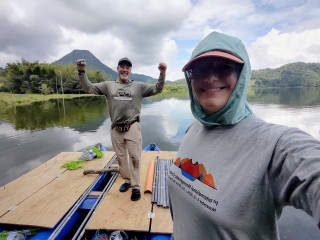
Dr. Power and Dr. Velasquez-Franco coring Laguna de San Diego in November 2024.
Along the way, their work is contributing to current-day discoveries. What Isabella and Zoe are doing with ancient environmental DNA is a growing area of research. There are many who are attempting various methods of extracting sedaDNA, trying to overcome the challenges of DNA contamination and degradation. Susana attempted this twice before with little success. However, when she cored the Cerro Machín wetland, what she found surprised her: “My mind was blown—you can pull complete plants out of the core, even if they are over 1,000 years old!” Using this new gyttja record, which promised richer data, she refined her approach with the help of NHMU Curator of Mycology Dr. Bryn Dentinger, who has experience with the specialized methods and equipment she needed. She then invited students to join in, turning the labs into a buzzing hub. This type of project demands significant resources—equipment, samples, and funding—that are rarely accessible outside of an established institution like NHMU. For students, it’s a once-in-a-lifetime opportunity, and they’re thrilled to be a part of it.
The energy these students bring to the lab is contagious. Susana has been working at the Museum for seven years, and this is the first time she’s seen the labs so alive. These students are working side by side every day—trying, failing, learning, and succeeding together. This is where discovery flourishes.
Ripples of Discovery
Aside from the rewarding experience students receive, they are invaluable to the Museum’s Collections and Research team.
Susana received a fellowship from the SRI program and NHMU to pilot this stream—the Museum’s first—and she’s hoping others will follow suit. “There are so many options here,” she said, noting the variety of research underway and the greater flexibility a museum allows compared to university labs.
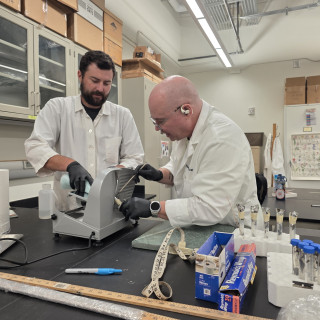
SRI stream students Charlie S. Davison and Geoffrey E. Ferrer performing high-resolution (~2 mm) subsampling on Utah Lake sedimentary records.
She admits running a stream requires significant time and energy upfront, as rewarding as it is. It takes several weeks of consistent lab time to train the students and get them comfortable with the equipment and lab workflows. During the first few weeks of the semester, Susana spent approximately 65 percent of her time training her 12 students, but this commitment dropped significantly once they were fully up to speed. Now, the students handle the majority of data collection, greatly accelerating her project’s timeline and freeing her focus for other work.
With their help, she plans to compile the data by late November. After which, she’ll work with Dr. Dentinger and Dr. Power on writing a new publication, sharing her new methods developed for the Cerro Machín record. She hopes to also collaborate with a few of her students on international publications.
Gaining Momentum
Susana will be leaving the Museum later this year to move to back to Colombia where she has accepted a new job with the Colombian Geological Survey. However, she hopes her experience here will inspire SRI and NHMU to fund more postdoctoral researcher streams.
With more streams like these, the Museum can become a mutually beneficial classroom where curiosity meets action, advancing both students’ education and the Museum’s impact.


